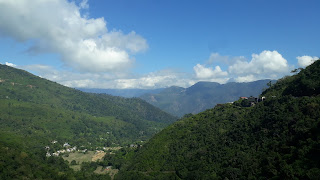'Rishikesh' inside out
Recalling the last week's visit to Rishikesh, and apart from the usually discussed natural beauty & the beautiful sight of the Ganga river what struck me hard is the people’s memory of the Uttarakhand floods in 2013. It had caused enormous loss of lives & properties. More than 6,000 people lost their lives and thousands of them lost their livelihood.
October 2021 – my visit
It has so happened that there were
heavy rains in the upper parts of the Himalayas during my visit last week and
in just three days of downpour, there was already a tumultuous flood in the
Ganga. The crystal clear water of the silently flowing river marred with the
fresh alluvial soil and it must be flowing by at least 2 meters above its usual
October level. We could see many uprooted trees were flowing with the river. All
the Ghats were flooded. There were reports of several landslides and this
caused the Chardham yatra to be stopped.
It was at this pretext that I
have encountered several people belittling this flood and talking about the 2013
floods and the fear in their faces while they talk about it. One lady who was
selling fruits by the street told me that she has never seen anything of such
scale. The foreigners were stranded. Humans and animals could be seen flowing
with the river along with the houses, vehicles, and trees. People have to be fed
with airlifted food.
Rishikesh
It’s a beautiful place surrounded
by the lower ranges of the Shivalik Himalayas. The beauty is further aggravated by
the sight of the Ganga river which until here was majorly flowing beneath the rocks and
boulders in the upper Himalayan ranges. It is further down in the city of
Haridwar that Ganga could be seen flowing at its fullest might. The river water
is usually cold even during the peak of the Summer season. Moving down further in
the lower plains that it is polluted with industrial dumps and untreated sewage
waste that the quality of the water would severely deteriorate. There are more
than 900 dams in the Ganga river. The river and several of its tributaries are
the lifelines of more than half of the population of the India.
It is since ancient times that
with the setting up of civilizations, kings and Monarchs would capitalize
religion and they would build big temples and beautiful architecture to mark
their positions as benevolent caretaker of their subjects. These religious
centers would be populated by markets and administrative centers and within no
time become the economic centers of the region. Large number of people would
come to visit the established shrines, or to get their work done, or to procure
material for their businesses, and so on. Indian temples have been famous for
their enormous wealth even today. This is so, many big businessmen and even simple common men would donate something while they would visit here.
The visit to these Himalayan towns
and further up into the colder zones were made more accessible during recent times. With the commercialization of the tourism sector and also due to
the increasing population, it is today that we see huge crowds in these
tectonically unstable places. It is a matter of huge debate and dilemma, do
every one of them who come to visit these places really understand the
ecological importance of it? Comparing to the peninsular part of India which is hard rock & these mountains are moving towards north.
Religion & Sages
India has been a land of devoted sages
and learned men who would leave behind the luxuries of life and their families
and other relationships and live a free man’s life. No, it is not that simple
as it seems. They perform austerities & live in great isolation, away from friends, family, sex, delicious food & trade. They live
with meager lifestyle, eat what has been bestowed to them by good people and
mostly wear a simple cotton cloth to cover their bodies. Comparing them with the pompous ones popular in the media would be a mistake. There are many who do
not wear anything at all in their bodies. They mostly live away from the ‘civilized’
societies. In Rishikesh, they are found in quantum numbers. It’s a place of
sages to be, and thus we will discuss why is it so and also how we understand the Indian form of
liberty?
Rishikesh is heavily populated
with Ashrams, trusts and various spiritual centers. Here, common people could discuss
several Indian scriptures, learn Yoga and meditation and so on. It’s an
attractive site to many foreign tourists who come here for seeking peace and
also un-braiding several life-related questions. We may need to ponder into
this contrast and its importance in the current Indian milieu. We may also need
to think doubly about its long-term sustenance and continuous higher creative output.
It is 5 O clock in the morning. The cold wind was flowing with uncommon sweetness. Not many people are awake. We could
hear the sound of Ganga flowing silently at its pace. It's flooded. Several sages are up and
sitting beside the Ganga river, performing their daily rituals, many meditating
in deep silence. The valley from which the Ganga flows is surrounded by the Himalayas. It is a sight to behold. It is peace-giving. This must be the most
important period of the day, as with time people will flock to the Ghats in
large numbers. Many would crowd the place for clicking selfies etc. 300 kilometers away from this place towards the south, is the capital
city of Delhi, the most polluted and most populated city of the world. In 2019,
it broke all the records of air pollution and several people were reported
with respiratory ailments. Will an ascetic be able to live here?
It is thoughtful to realize that people could be eccentrically religious in their outlook and also in their ways and it will be tolerated by the society! No judgements. One is free to experiment our ways. Ascetics have been considered the
assets of the country. They are considered above the rigid caste system that
prevails in the country. They have been the soul of the cultural enigma that
people from all strata follow. Many of these sages discussed, debated and
wrote several works of literature that now form a sacred part of Hinduism, Buddhism, Sikhism and Jainism.
It has been made possible because of the resonating effect of the liberal
traditions that must have been allowed by the people and the authority simultaneously.
Yet, we know that the country has seen peaks of the prevalence of different sects
and their forms over time. These mountains belong to no one religion, no one
belief & no one sect.
Liberty
It must be 6:30 AM that I have
strolled enough near the Ghats and pondered over the views that it offers. Many
of the tea stalls are now in action. Over the streets, we see plastic litters,
cow dung, bidi leftovers, reddish pan stains and so on. As I sat across a stall, I hear
an orange-clad sadhu talking to another, “they say that, see! That sadhu has a
mobile phone! Cannot we have mobile phones? What is wrong with it? We also have
to talk to some people and don’t you remember that during the floods how it
helped all of us!”. Another replied, “Yeah, you see that the food that is meant
for us sadhus is diverted to somewhere else…”. He had a polythene in which was kept some fruits, chapatis and some curry.
It is true that several of the
sadhus are not committed to ascetism. They may just be escaping the labor
of living a life in the capitalist-feudalistic structured mainstream society.
Nowadays, many Indian ascetics have toiled their name in scandals that have
given them a bad name. How should modern polity respond to this? What is the limit? Is there a limit? What's considered dogmatic & how to segregate? If any, will it effect the liberty overall?
It’s 7 ‘O'clock and after having
a dip in the holy river, I was now walking in the streets of Rishikesh. There
are several ashrams and temples along the way. Well, as I was walking down, I
could hear the mesmerizing sound of ‘hare Rama,
hare Krishna' bhajans played over
harmonium and tongs. I peeked through one of them and through eye contact asked
for permission if I could be a part of it? It was swiftly accepted and soon
I found a corner to sit silently. It was a powerful moment as I experienced easy acceptance and accessibility. Over the part of the day, I must have sat in
4-5 such ashrams and became part the environment. I was not denied admission
anywhere! There were no entry fees. Your caste and religious background will
not be asked! Like this, we could freely enter many ashrams and experience a
peaceful environment. I felt equal, unexposed and common merit. Several of
these ashrams are funded by good people. There are several cheap ashrams for accommodations
too. It is obviously in sharp contrast to the commercial phenomenon taking place
side by side. There are fancy restaurants, sporty adventures, resorts, shops
and so on. The place will soon be bustling with a mixed crowd.
Governance
It was 10:30 PM. The Ghats were
empty. I was safely sitting by one of the Ghats and looking over the flooded
Ganga. There was a sudden loud announcement that there was a release of excess
water from the dam upstream and it may increase the water level of the river.
It was to warn the people sitting nearby to be alert.
Across the Ghats, over several
sheds, the sages were freely accommodating the space. It gives a sense of
safety and stability, although I could not have a chance of encountering a
women sage and it was deeply moving. I could see several tourists and also ‘sages’
having shots of marijuana. Now, this is a troubling debate because of the
interrelation of drug channels and organized crimes in the country. There
is also a danger of alienation and drug addiction. Should it be considered part
of liberty? Many countries are now legalizing this plant. In India, it is
allowed for medical research purposes, however, it is secretly prevalent all
over the country.
While the city was fast asleep at
this time of the hour, up over the mountains I could see jiggling lights of fossil-based
vehicles making their way into the upper reaches…
At last, we know that India is a lower-middle-class developing country. We went through several foreign invasions and a strong 200 years of colonialism that made us poor & hungry. Before the 1700s, the Indian subcontinent was one of the affluent economic centers of the world. Now we are at a dispatch of severe developmental parameters, dwindling polity, over-buzzing crimes, conflicts and a huge population with meager resources. Many of the developed countries are living their 21st century and they are the path developer too. Post-Independence we chose an equidistant form of the secular republic. We had huge dreams and continue to do so. While we are the youngest country in the world, it is Himalayan time to ponder deeply and bring sustainability to our people. Not to forget that cultural diversity has continued to be our most strong organ… Lovely times... I remain grateful.







Comments
Post a Comment